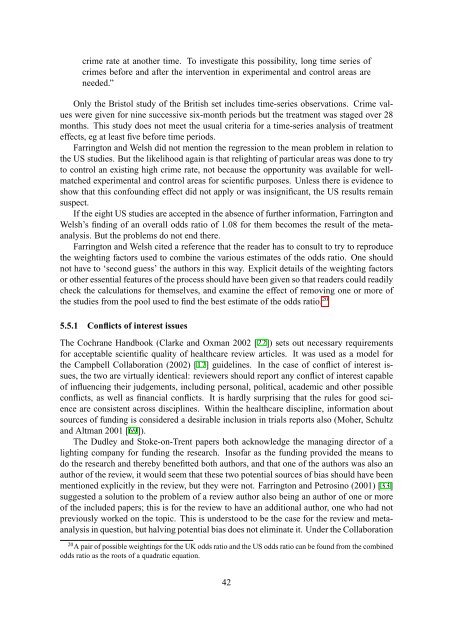outdoor lighting and crime, part 1 - Astronomical Society of Victoria
outdoor lighting and crime, part 1 - Astronomical Society of Victoria
outdoor lighting and crime, part 1 - Astronomical Society of Victoria
Create successful ePaper yourself
Turn your PDF publications into a flip-book with our unique Google optimized e-Paper software.
<strong>crime</strong> rate at another time. To investigate this possibility, long time series <strong>of</strong><br />
<strong>crime</strong>s before <strong>and</strong> after the intervention in experimental <strong>and</strong> control areas are<br />
needed.”<br />
Only the Bristol study <strong>of</strong> the British set includes time-series observations. Crime values<br />
were given for nine successive six-month periods but the treatment was staged over 28<br />
months. This study does not meet the usual criteria for a time-series analysis <strong>of</strong> treatment<br />
effects, eg at least five before time periods.<br />
Farrington <strong>and</strong> Welsh did not mention the regression to the mean problem in relation to<br />
the US studies. But the likelihood again is that re<strong>lighting</strong> <strong>of</strong> <strong>part</strong>icular areas was done to try<br />
to control an existing high <strong>crime</strong> rate, not because the opportunity was available for wellmatched<br />
experimental <strong>and</strong> control areas for scientific purposes. Unless there is evidence to<br />
show that this confounding effect did not apply or was insignificant, the US results remain<br />
suspect.<br />
If the eight US studies are accepted in the absence <strong>of</strong> further information, Farrington <strong>and</strong><br />
Welsh’s finding <strong>of</strong> an overall odds ratio <strong>of</strong> 1.08 for them becomes the result <strong>of</strong> the metaanalysis.<br />
But the problems do not end there.<br />
Farrington <strong>and</strong> Welsh cited a reference that the reader has to consult to try to reproduce<br />
the weighting factors used to combine the various estimates <strong>of</strong> the odds ratio. One should<br />
not have to ‘second guess’ the authors in this way. Explicit details <strong>of</strong> the weighting factors<br />
or other essential features <strong>of</strong> the process should have been given so that readers could readily<br />
check the calculations for themselves, <strong>and</strong> examine the effect <strong>of</strong> removing one or more <strong>of</strong><br />
the studies from the pool used to find the best estimate <strong>of</strong> the odds ratio. 20<br />
5.5.1 Conflicts <strong>of</strong> interest issues<br />
The Cochrane H<strong>and</strong>book (Clarke <strong>and</strong> Oxman 2002 [22]) sets out necessary requirements<br />
for acceptable scientific quality <strong>of</strong> healthcare review articles. It was used as a model for<br />
the Campbell Collaboration (2002) [17] guidelines. In the case <strong>of</strong> conflict <strong>of</strong> interest issues,<br />
the two are virtually identical: reviewers should report any conflict <strong>of</strong> interest capable<br />
<strong>of</strong> influencing their judgements, including personal, political, academic <strong>and</strong> other possible<br />
conflicts, as well as financial conflicts. It is hardly surprising that the rules for good science<br />
are consistent across disciplines. Within the healthcare discipline, information about<br />
sources <strong>of</strong> funding is considered a desirable inclusion in trials reports also (Moher, Schultz<br />
<strong>and</strong> Altman 2001 [69]).<br />
The Dudley <strong>and</strong> Stoke-on-Trent papers both acknowledge the managing director <strong>of</strong> a<br />
<strong>lighting</strong> company for funding the research. Ins<strong>of</strong>ar as the funding provided the means to<br />
do the research <strong>and</strong> thereby benefitted both authors, <strong>and</strong> that one <strong>of</strong> the authors was also an<br />
author <strong>of</strong> the review, it would seem that these two potential sources <strong>of</strong> bias should have been<br />
mentioned explicitly in the review, but they were not. Farrington <strong>and</strong> Petrosino (2001) [33]<br />
suggested a solution to the problem <strong>of</strong> a review author also being an author <strong>of</strong> one or more<br />
<strong>of</strong> the included papers; this is for the review to have an additional author, one who had not<br />
previously worked on the topic. This is understood to be the case for the review <strong>and</strong> metaanalysis<br />
in question, but halving potential bias does not eliminate it. Under the Collaboration<br />
20 A pair <strong>of</strong> possible weightings for the UK odds ratio <strong>and</strong> the US odds ratio can be found from the combined<br />
odds ratio as the roots <strong>of</strong> a quadratic equation.<br />
42
















